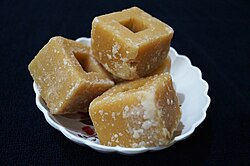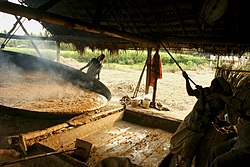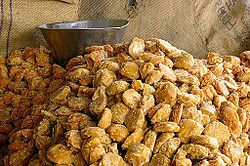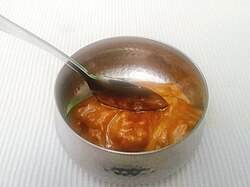Jaggery

Jaggery

Jaggery is a traditional unrefined sugar made from sugarcane or date palm sap. It is widely consumed in various parts of the world, especially in Asia, Africa, and Latin America. Jaggery is known for its distinctive flavor and unique nutritional properties. It is commonly used as a sweetener in many traditional dishes and desserts.
Production
Jaggery is produced by extracting the juice from sugarcane or date palm, which is then heated to evaporate the water content. The concentrated juice is stirred continuously until it thickens and solidifies. The resulting product is molded into blocks or cones, which are then allowed to cool and harden. The production process of jaggery retains more of the natural nutrients compared to refined sugar.
Varieties
There are different varieties of jaggery, depending on the source and processing methods. Cane jaggery is made from sugarcane juice and is the most common type. Palm jaggery is made from the sap of palm trees and is widely consumed in tropical regions. Both types have a distinct flavor profile and are used in various culinary preparations.
Nutritional Benefits
Jaggery is considered a healthier alternative to refined sugar due to its higher nutrient content. It is rich in iron, which is essential for the production of red blood cells and maintaining energy levels. Jaggery also contains traces of other minerals such as calcium, magnesium, and potassium. Additionally, it is a natural source of antioxidants and may have anti-inflammatory properties.
Culinary Uses
Jaggery is widely used in traditional cuisines for its unique flavor and aroma. It is commonly used in desserts, sweets, and confectionery items. In Indian cuisine, jaggery is a key ingredient in popular dishes like jaggery rice, jaggery-based sweets like ladoo and halwa, and beverages like jaggery tea. It is also used in the preparation of traditional medicines and Ayurvedic remedies.
Health Benefits
Apart from its nutritional value, jaggery offers several health benefits. It is believed to aid in digestion and is often consumed after meals to improve digestive health. Jaggery is also known to help alleviate cough and cold symptoms and is sometimes used as a natural remedy for respiratory problems. However, it is important to consume jaggery in moderation due to its high sugar content.
References
<references/>
Nutritional information on Jaggery
|
|
 |
| Food Portal | Food | Nutrition | Diet | Keto | Glycemic index |
NB:Carbohydrate, by difference(total carbs-fiber) is also called net carbs

Image gallery
-
Jaggery cubes
-
Jaggery (gur) making at small scale near sugarcane farm in Pakistan.
-
Boiling the sugarcane juice in large-scale jaggery (gur) making in India.
-
Transferring boiled sugarcane juice into vessel to dry.
-
Gud or jaggery: Sugarcane-derived raw sugar crystallised cubes or blocks.
-
Jaggery blocks, also known as gud
-
Gur mamra laddu sweets made from jaggery and puffed rice.
-
Indian Jaggery
| Sugar as food commodity | ||||||||||||||||||||||||||
|---|---|---|---|---|---|---|---|---|---|---|---|---|---|---|---|---|---|---|---|---|---|---|---|---|---|---|
|
List of sugars and sugar products
|
|
Ad. Transform your life with W8MD's Budget GLP-1 injections from $75


W8MD offers a medical weight loss program to lose weight in Philadelphia. Our physician-supervised medical weight loss provides:
- Weight loss injections in NYC (generic and brand names):
- Zepbound / Mounjaro, Wegovy / Ozempic, Saxenda
- Most insurances accepted or discounted self-pay rates. We will obtain insurance prior authorizations if needed.
- Generic GLP1 weight loss injections from $75 for the starting dose.
- Also offer prescription weight loss medications including Phentermine, Qsymia, Diethylpropion, Contrave etc.
NYC weight loss doctor appointmentsNYC weight loss doctor appointments
Start your NYC weight loss journey today at our NYC medical weight loss and Philadelphia medical weight loss clinics.
- Call 718-946-5500 to lose weight in NYC or for medical weight loss in Philadelphia 215-676-2334.
- Tags:NYC medical weight loss, Philadelphia lose weight Zepbound NYC, Budget GLP1 weight loss injections, Wegovy Philadelphia, Wegovy NYC, Philadelphia medical weight loss, Brookly weight loss and Wegovy NYC
|
WikiMD's Wellness Encyclopedia |
| Let Food Be Thy Medicine Medicine Thy Food - Hippocrates |
Medical Disclaimer: WikiMD is not a substitute for professional medical advice. The information on WikiMD is provided as an information resource only, may be incorrect, outdated or misleading, and is not to be used or relied on for any diagnostic or treatment purposes. Please consult your health care provider before making any healthcare decisions or for guidance about a specific medical condition. WikiMD expressly disclaims responsibility, and shall have no liability, for any damages, loss, injury, or liability whatsoever suffered as a result of your reliance on the information contained in this site. By visiting this site you agree to the foregoing terms and conditions, which may from time to time be changed or supplemented by WikiMD. If you do not agree to the foregoing terms and conditions, you should not enter or use this site. See full disclaimer.
Credits:Most images are courtesy of Wikimedia commons, and templates, categories Wikipedia, licensed under CC BY SA or similar.
Translate this page: - East Asian
中文,
日本,
한국어,
South Asian
हिन्दी,
தமிழ்,
తెలుగు,
Urdu,
ಕನ್ನಡ,
Southeast Asian
Indonesian,
Vietnamese,
Thai,
မြန်မာဘာသာ,
বাংলা
European
español,
Deutsch,
français,
Greek,
português do Brasil,
polski,
română,
русский,
Nederlands,
norsk,
svenska,
suomi,
Italian
Middle Eastern & African
عربى,
Turkish,
Persian,
Hebrew,
Afrikaans,
isiZulu,
Kiswahili,
Other
Bulgarian,
Hungarian,
Czech,
Swedish,
മലയാളം,
मराठी,
ਪੰਜਾਬੀ,
ગુજરાતી,
Portuguese,
Ukrainian









